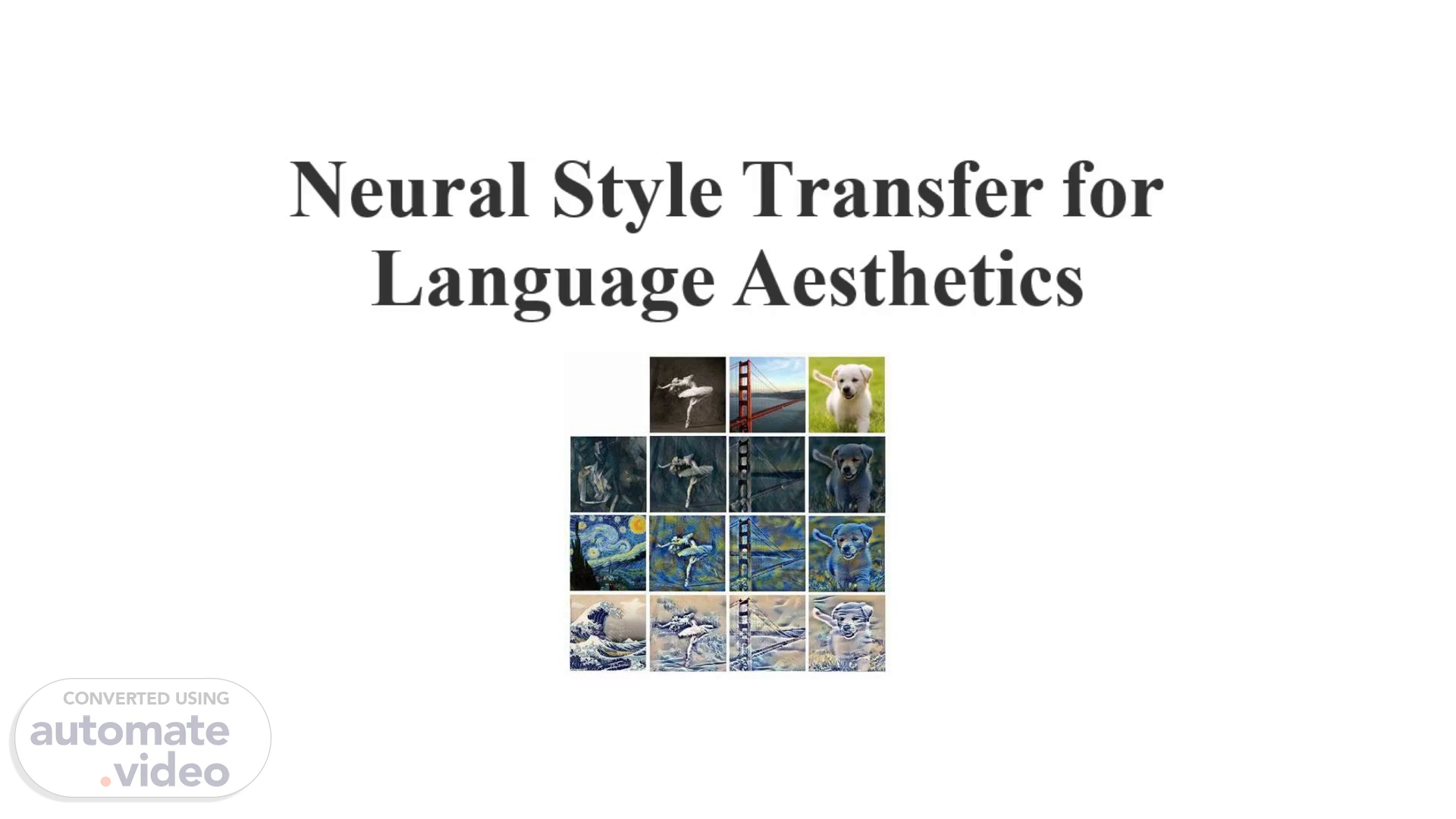
Neural Style Transfer for Language Aesthetics
Scene 1 (0s)
[Audio] This is Our project title is neural style transfer for language aesthetics.
Scene 2 (6s)
[Audio] These are our team members. Team details:.
Scene 3 (20s)
[Audio] In this project, we delve into the adaptation of Neural Style Transfer (NST) from its visual roots into the realm of language. By merging various artistic styles with linguistic elements, we aim to enhance the aesthetic qualities of written expression..
Scene 4 (57s)
Neural Style Transfer, originally developed for image processing tasks, offers a promising avenue for adapting the visual and textual elements of digital platforms to the aesthetic preferences of diverse language communities. By training models to transfer the aesthetic characteristics of one language to the textual elements of another, e-commerce platforms can create a more immersive and culturally relevant user experience. In this paper, we explore the application of Neural Style Transfer techniques to address the challenge of language aesthetics adaptation in the context of e- commerce platforms catering to Indic languages. Drawing on insights from linguistics, design theory, and machine learning, we propose a framework for training and deploying NST models capable of seamlessly integrating language-specific visual styles into the user interface..
Scene 5 (1m 29s)
[Audio] "In adapting Neural Style Transfer (NST) for language aesthetics, we carefully selected neural network architectures and outlined key steps. Our dataset, rich in diverse linguistic styles and artistic influences, underwent meticulous pre-processing. The results showcase our NST model's proficiency in translating artistic styles into written language. We explore practical applications, from enhancing creative writing to generating purpose-specific content. Despite challenges, we discuss the potential impact and promising avenues for future work at the intersection of neural style transfer and language aesthetics.".
Scene 6 (2m 14s)
Understanding Language Aesthetics: Conduct in-depth research on the aesthetic preferences associated with different Indic languages. This could involve studying traditional typography, cultural motifs, color symbolism, and contemporary design trends specific to each language community. Consult with language experts, designers, and native speakers to gain insights into the nuances of language aesthetics and how they can be effectively translated into visual elements. Dataset Preparation: Gather a comprehensive dataset of text samples in various Indic languages along with associated visual styles. This dataset should cover a wide range of topics and contexts relevant to e-commerce, such as product descriptions, customer reviews, and promotional content. Include diverse examples of typography, including different fonts, font sizes, font weights, and font styles commonly used in each Indic language. Curate visual representations that reflect the aesthetic preferences of each language community, including color schemes, graphic elements, and layout designs..
Scene 7 (2m 53s)
Model Selection: Explore existing NST models that have been adapted or designed for textual style transfer tasks. Consider models that demonstrate effectiveness in preserving content while transferring style across different domains. Adapt or develop new models specifically tailored for the unique challenges of language aesthetics transfer. This may involve modifying existing architectures or incorporating language-specific features into the model design. Training the Model: Preprocess the dataset to prepare input text samples and corresponding visual style representations. This may involve tokenization, normalization, and encoding of textual data, as well as image preprocessing techniques such as resizing and normalization. Train the selected NST model using the prepared dataset, optimizing for objectives such as style fidelity, content preservation, and computational efficiency..
Scene 8 (3m 25s)
Evaluation: Evaluate the performance of the trained model using a combination of qualitative and quantitative metrics. Conduct qualitative assessments by soliciting feedback from language experts, designers, and native speakers on the visual quality and cultural authenticity of the generated outputs. Quantitatively measure factors such as perceptual similarity, style transfer accuracy, and content preservation using established evaluation metrics and benchmarks. Fine-Tuning and Iteration: Iterate on the model architecture, training process, and dataset curation based on evaluation feedback. Fine-tune model hyperparameters, such as learning rates, batch sizes, and regularization techniques, to improve convergence and generalization performance..
Scene 9 (3m 53s)
Integration with E-commerce Platform: Integrate the trained model into the backend infrastructure of the e-commerce platform, providing an interface for users to customize the visual aesthetics of their browsing experience. Implement mechanisms for dynamically applying language-specific visual styles to textual elements displayed on the platform based on user preferences. Ensure compatibility with existing localization features and support for a wide range of Indic languages and dialects. User Feedback and Continuous Improvement: Solicit feedback from platform users regarding the effectiveness and usability of the language aesthetics adaptation feature. Monitor user interactions and gather usage analytics to identify areas for improvement and optimization. Continuously update and refine the model based on user feedback, emerging design trends, and advancements in NST research to maintain relevance and effectiveness over time..
Scene 10 (4m 26s)
[Audio] our project highlights the successful fusion of art and language aesthetics through Neural Style Transfer. The showcased results underscore the model's ability to enhance written expression with diverse artistic styles. As we reflect on the journey, the applications in creative writing and content generation become evident. Moving forward, the potential impact on diverse fields is compelling, making Neural Style Transfer a powerful tool for advancing linguistic aesthetics and creative endeavors.".